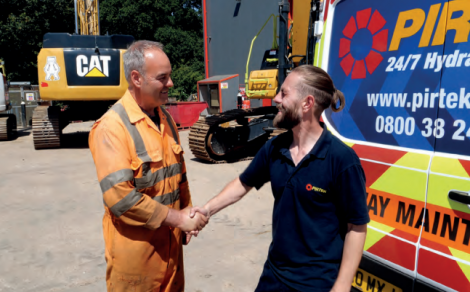- Home » Editorial » Hydraulics
Prioritising hydraulic health and safety

In construction, problems will often occur when a hydraulic hose is damaged by the surrounding environment where nicks, cuts, and tears can happen easily – and in extreme cases, the hose can be severed or crushed. No matter the scenario, a hydraulic hose must never be repaired due to the dangers associated with high pressure systems, instead it must be replaced with new, safe components. Yet, there is a naivety and lack of understanding surrounding the dangers of a damaged hose. For example, if a hydraulic hose bursts, the pressure and heat of the fluid can lead to burns and infections and the potential of a fluid injection injury. If not treated quickly, injection injuries can result in amputation and even death.
Taking responsibility
Unfortunately, this lack of awareness in combination with tighter budgets means there is a tendency for hoses to be repaired using a DIY fix or re-ended; the process where the last few inches of the hose is cut off and replaced with new fittings to artificially extend its life. The British Fluid Power Association (BFPA) strongly advice against this practice stating that trade associations, industry experts and safety bodies all agree that the risks are too great; but the problem of re-ending is still prevalent across the industry.
Businesses within the construction and plant hire industries need to keep their people safe by ensuring anyone dealing with hydraulic hoses receives hydraulic safety awareness training to help reduce the risks involved. This should be provided by industry experts who are members of the BFPA to make sure that the training delivered is to a high standard and up to date. This can be complemented by implementing robust inspection and reporting procedures to monitor equipment usage, condition and if any maintenance has taken place.
To further ensure safety and compliance, it is crucial that hydraulic hoses are treated with the same level of attention and importance as other high-risk components. When a failure occurs and an emergency callout is required, the best course of action is to contact a hydraulic hose specialist that understands the potential dangers at a construction site. Partnering with a best-in-class hydraulic hose expert will mean a technician is onsite quickly and a quality service will be delivered. Planned maintenance and servicing can also help reduce the level of risk, and using suppliers accredited by the BFPA’s Approved Hose Assemblies Scheme means that everything from hose manufacturing and assembly through to distribution and fitting will comply with best practice safety procedures.
Hydraulics is just one cog on the health and safety agenda in construction, but it shouldn’t be underestimated as one mistake could have disastrous consequences for the company and individuals involved. Failure of hydraulics can also have serious repercussions for the downtime of equipment so ensuring that any replacements or maintenance is done by experts is vital. Health and safety leaders in the industry have a duty of care to offer training, promote awareness and make sure the right suppliers are being used at all times. Taking responsibility now can help protect tomorrow’s worker.
For further information please visit: https://www.pirtek.co.uk/training-courses/
https://twitter.com/PirtekUKIreland
https://www.linkedin.com/company/pirtek-uk-ltd/
-
SMART Manufacturing & Engineering Week
04 - 05 June, 2025
NEC, Birmingham UK -
PPMA 2025
23 September, 2025, 9:30 - 25 September, 2025, 16:00
NEC, Birmingham UK -
Advanced Engineering Show 2025
29 October, 2025, 9:00 - 30 October, 2025, 16:00
NEC, Birmingham UK










